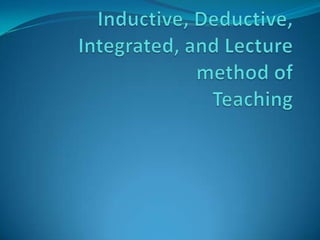
Inductive, Deductive, Integrated and Lecture Method of Teaching
- 2. If a single teacher can’t teach all of the subjects, then how could you expect to a single student to learn all the subjects.
- 4. Inductive method The inductive teaching method or process goes from the specific to the general and may be based on specific experiments or experimental learning exercises. Deductive teaching method progresses from general concept to the specific use or application.
- 5. Inductive teaching is a constructivist model of teaching that is more student-centered. In inductive teaching first provide examples, then have students practice and figure out the rule themselves. This method of teaching is more experiential and based on a guided discovery learning philosophy.
- 6. For example, if the structure to be presented is the comparative form, the teacher would begin the lesson by drawing a figure on the board and saying, "This is Jim. He is tall." Then, the teacher would draw another taller figure next to the first saying, "This is Bill. He is taller than Jim." The teacher would then provide many examples using students and items from the classroom, famous people, or anything within the normal daily life of the students, to create an understanding of the use of the structure. The students repeat after the teacher, after each of the different examples, and eventually practice the structures meaningfully in groups or pairs. With this approach, the teacher's role is to provide meaningful contexts to encourage demonstration of the rule, while the students evolve the rules from the examples of its use and continued practice.
- 8. Deductive method of teaching Deductive teaching is a more traditional form of teaching. In deductive teaching you typically provide information(lecture), share specific examples of the concept or skill being taught. This is a more teacher- centered model of teaching that is rule driven. Some of the positives of this method are that it is timesaving and gets to the point of the lesson easily.
- 9. For example, if the structure to be presented is present perfect, the teacher would begin the lesson by saying, "Today we are going to learn how to use the present perfect structure". Then, the rules of the present perfect structure would be outlined and the students would complete exercises, in a number of ways, to practice using the structure.In this approach, the teacher is the center of the class and is responsible for all of the presentation and explanation of the new material.
- 10. To conclude, we can say that inductive method is a predecessor of deductive method. Any loss of time due to slowness of this method is made up through the quick and time saving process of deduction. Deduction is a process particularly suitable for a final statement and induction is most suitable for exploration of new fields. Probability in induction is raised to certainty in deduction. The happy combination of the two is most appropriate and desirable.
- 12. Integrated Method Basically refers to the method of teaching wherein various styles are incorporated to each other in a way that should boost the learning experience that is to be imparted.
- 13. Allows students to make natural connections between content areas without being limited by artificial boundaries. In doing so, students construct their own meaning and develop skills they will need in the workplace.Integrated Method involves one or all of the following: Examining a topic from different points of view (disciplines) Placing greater emphasis on projects
- 14. Encouraging students to recognize the relationships among and between concepts Using thematic units as organizing principles Flexible schedules Flexible student groupings
- 16. It is the practice of having the teacher, or lecturer, at the front of the classroom talking to students. This is seen as one-way communication, since the lecturer is the only one speaking. An effective use of this is a short talk to provide students with the background information they need to do the work.
- 17. The lecture method is the most widely used form of presentation. Every instructor should know how to develop and present a lecture. They also should understand the advantages and limitations of this method. Lectures are used for introduction of new subjects, summarizing ideas, showing relationships between theory and practice, and reemphasizing main points. The lecture method is adaptable to many different settings, including either small or large groups. Lectures also may be used to introduce a unit of instruction or a complete training program. Finally, lectures may be combined with other teaching methods to give added meaning and direction.
- 18. The lecture method of teaching needs to be very flexible since it may be used in different ways. For example, there are several types of lectures such as the illustrated talk where the speaker relies heavily on visual aids to convey ideas to the listeners. With a briefing, the speaker presents a concise array of facts to the listeners who normally do not expect elaboration of supporting material.
- 19. During a formal lecture, the speaker's purpose is to inform, to persuade, or to entertain with little or no verbal participation by the students. When using a teaching lecture, the instructor plans and delivers an oral presentation in a manner that allows some participation by the students and helps direct them toward the desired learning outcomes.
